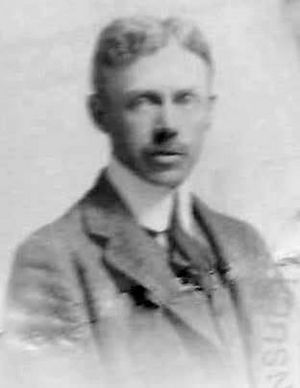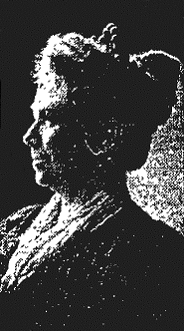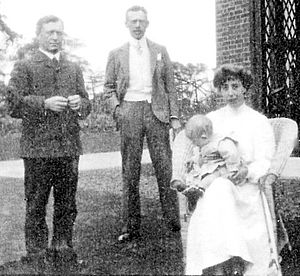Howard Burnham facts for kids
Quick facts for kids Mather Howard Burnham |
|
|---|---|

M. Howard Burnham, 1915
|
|
| Allegiance | United States, France |
| Active | World War I |
|
|
|
| Born | May 27, 1870 Tivoli, Minnesota (near Mankato), United States |
| Died | May 4, 1917 (aged 46) New York City, US |
| Buried | New York City, New York |
| Nationality | American |
| Parents | Rev Edwin Otway Burnham Rebecca Russell Burnham |
| Spouse |
|
| Children | 4 |
| Occupation | Mining engineer, Spy |
| Alma mater | Michigan Technological University |
Mather Howard Burnham (born May 27, 1870 – died May 4, 1917) was an American adventurer. Most people called him Howard. His brother, Frederick Russell Burnham, was a famous scout. Howard traveled all over the world. He often worked as an engineer, helping to dig for valuable minerals. During World War I, he became a secret agent, or spy, for France. He even had a wooden leg where he hid his spy tools when he was in enemy territory!
Contents
Howard Burnham's Early Life
Howard Burnham was born into a missionary family. This happened on a Sioux Indian reservation in Tivoli, Minnesota. His family soon moved to Los Angeles, California. He was named after his cousin, Lieutenant Howard Mather Burnham. This cousin was a US Army officer who died in the American Civil War.
Howard's father, Reverend Edwin Otway Burnham, was a missionary and frontiersman. He died when Howard was only three years old. This left the family without much money. Howard and his mother, Rebecca Russell Burnham, moved to Iowa to live with an uncle. His older brother, Fred, stayed in California. Fred was 12 and wanted to earn money to help the family.
A Difficult Start
When Howard was 14, he was in school in Massachusetts. He became very sick and injured his leg. His brother Fred sent him money to return to Los Angeles. Sadly, his leg had to be removed just below the knee. Howard also suffered from tuberculosis, a serious lung illness.
After his surgery, he spent two years recovering. He lived with his brother Fred during this time. Fred taught him many outdoor skills, like shooting and riding horses. He learned how to be a scout, even with his new wooden leg.
Howard loved to read and had an amazing memory. He enjoyed books about military plans and history. He was also fascinated by geology (the study of rocks), metallurgy (the study of metals), and mining. He explored the deserts from Death Valley to lower California. He lived with and learned from the Cahuilla Indians. He also teamed up with gold prospectors to learn about finding valuable minerals.
Desert Danger
In 1888, Howard was exploring the desert. He had a dangerous encounter with an Indian man. Howard was on a mountain trail when he met the man and spoke with him. Soon after, Howard felt something hit his right leg. Then, his left leg was wounded.
He quickly dropped to the ground. He saw a hat behind a rock about 150 yards away. Howard fired his pistol at the hat. The man ran away down a canyon trail. Howard realized it was the same man he had just met. He knew the man had a rifle, which was more powerful than his pistol. Howard left his supplies and quickly rode his horse down a steep cliff to safety in San Jacinto, California.
For the next few years, Howard studied mining. He worked as a mining engineer in the California desert. He worked at the Alvord gold mine, which was owned by his family and their partners. He earned his professional mining certificate from a company in San Francisco.
Adventures in South Africa
After the Alvord mine was destroyed by fire, Howard stayed in California. In 1894, he traveled to the South African Republic. He wanted to join his brother Fred, who was already in Bulawayo, Matabeleland. Howard quickly found work as a mining engineer. He was in charge of the lab at the Langlaagte Royal Mine.
In 1895, Howard planned to go on a big trip with his brother into Northern Rhodesia. But he became ill and had to go to Europe to get better. He traveled to Germany and then to London, England. In 1895, he married his first wife, Margaret.
He returned to the United States and studied at the Michigan Mining School. He graduated in 1898. By September 1898, he and his wife were back in Africa. He worked for an English company, overseeing over 2,000 miners at a gold mine near Johannesburg, South Africa. While in South Africa, Howard was a chief chemist and engineer. He even wrote a textbook called Modern Mine Valuation.
Caught in the Boer War
When the Second Boer War started in 1899, Howard thought his American citizenship would protect him. He stayed at his job in the mines. But he sent his wife to Cape Town, South Africa to be safe. The situation in Johannesburg quickly became dangerous. The Boers took control of the mine.
Howard traveled to East London, South Africa to tell the mine directors what happened. The British captured him and held him for 24 hours. He proved he was an American citizen and was released. But when he tried to go back to Johannesburg, the Boers captured him. They thought he was a British spy.
Howard sent a message to his family asking for money to help him. Just weeks before, his brother Fred was prospecting in Alaska. Fred received a telegram from Lord Roberts asking for his help in the war. Fred left for Africa right away. He was appointed Chief of Scouts for the British Army. But he was too far away to help Howard immediately.
Over the next few years, Howard lived in England and South Africa. He gave talks and wrote articles about mining. In 1903, he married Constance Newton in London. She was a school teacher and inherited money from a company. From 1905 to 1908, Howard was a special member of the Royal Colonial Institute in London.
Mining in Mexico
Howard's wife and children stayed in England and France. But Howard returned to North America in 1907. For several years, he worked on a big irrigation project in Mexico with his brother Fred. This project was along the Yaqui River.
In 1908, Howard explored Sonora, Mexico, looking for minerals. He was working for American and English business partners. He found several properties and thought one called La Fiera was the best. In 1909, he traveled with Hector Walker from England. They went on a 300-mile journey from Phoenix, Arizona into Mexico. They looked for good grazing lands and minerals.
His brother Fred bought water rights and land in this area. They contacted an old friend from Africa, John Hays Hammond. Hammond studied the land and bought even more, an area the size of Rhode Island.
The irrigation and mining projects were almost finished by 1912. But then, a long series of Mexican revolutions began. In 1917, Mexico passed laws that stopped foreigners from buying land. This ended the plans for the Burnham-Hammond projects. The families kept their properties until 1930, then sold them to the Mexican government.
World War I Spy Missions
During World War I, Howard Burnham worked as a spy for France. In 1914, he was arrested near Tampico, Mexico. He was suspected of being a spy. He was released with help from William Jennings Bryan, who was the US Secretary of State.
Howard immediately left Mexico for France. He stopped in Barcelona, Spain on his way to Algiers, Algeria. Algiers was a French colony, but German spies had secretly entered it to support rebels. Howard was sent on a dangerous mission. He had to lead 28 soldiers into the desert. Their goal was to meet with the rebels and convince them to make peace with the French.
A Narrow Escape
On their journey, Howard's group met a hostile clan. They lost 20 men and ran out of ammunition. Howard and the remaining soldiers were taken prisoner. Everyone was executed except Howard.
Earlier, a sheik (a leader) from that clan had been in trouble with the French in Algiers. Howard had helped him and defended him, which led to the sheik's release. Because of this past kindness, the sheik saved Howard's life. Howard returned to Algiers alone and was then sent to France.
Secret Mission in Germany
In 1917, French intelligence sent Howard across enemy lines as a spy. They wanted him to find out if the Germans were planning a new attack through the Alps mountains. Howard traveled through neutral Switzerland. He pretended to be an American mining engineer. He crossed into Germany, saying he was very sick. His tuberculosis had returned badly.
Before the war, Howard had spent a lot of time in German health resorts. His work for French intelligence was top secret. So, the German authorities did not suspect he was a spy. Also, he was traveling with a lot of American gold coins for his treatment. Germany desperately needed gold during the war. Still, Howard was searched and watched closely during his stay.
While in Germany, Howard used his engineering skills. He turned simple household items into tools for surveying (measuring land). He hid these tools in his wooden leg when he traveled. He visited places like Bad Nauheim. His treatments were very expensive, costing $500 a month in gold. This made him a welcome visitor at every resort in Germany. However, all his letters were read. German authorities insisted he often be escorted by nurses and a private secretary. Since he couldn't write down his findings, he relied on his amazing memory.
Howard became very ill. He was allowed to return to Switzerland for his health. The French government quickly moved him to Cannes, France. From his deathbed, Howard shared his secrets with other intelligence officers. The French government brought his family from England to Cannes. The information Howard gathered was very important. It showed that the Germans were not opening a new front in the Alps. This meant the allied troops did not need to move away from the Western Front.
His last words were whispered to his surgeon: "I always wanted to help pay the debt my country owed to France. Go back to the front and save the living. I am already dead." He was buried in Cannes. He was placed next to another American, A. Kingsley Macomber. This was to honor the French Admiral François Joseph Paul de Grasse. His fleet had helped George Washington defeat the British at Yorktown, Virginia in 1781.
Family Life
Howard Burnham was a descendant of Thomas Burnham (1617–1688). Thomas Burnham was one of the first American ancestors of many Burnhams. His descendants have fought in every American war, including the French and Indian war.
Howard had four children:
- Frederick Newton Burnham (born August 25, 1904 – died 1959), born in Lydenburg, Republic of South Africa. He died in Hastings, England.
- Thomas Chambers Burnham (born May 14, 1906 – died 2004), born in England. He died in Key Largo, Florida.
- Mary Burnham (born May 29, 1909 – died 1987), born in England. She died in London, England.
- Katherine "Kitty" Burnham (born October 9, 1911 – died 1999), born in San Francisco, California. She died in Tormarton, Bath, England.



